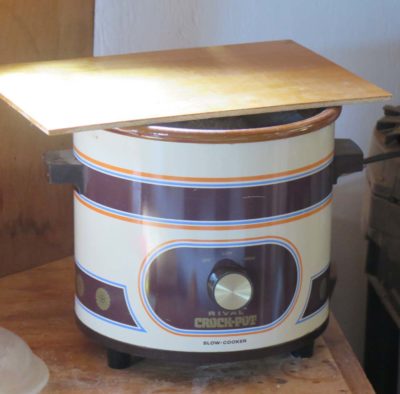Conditioning Silica Gel
One of the very useful tools for me is a desiccation chamber for drying out wet things, like uncured tordonshell, a fresh plaster casting, wet wood, or something similar. I achieve such a chamber by using either a Gamma pet food container or a five-gallon pail with a Gamma retrofit sealing lid. I load the chamber with desiccated silica gel and it is ready to do its work. Put something damp in there, tighten down the lid, and the moisture gets sucked out of whatever it is you are trying to dry.

But the silica gel eventually gets damp itself, or at least adsorbs all the water being removed from the object in question. Fortunately silica get can be re-conditioned an unlimited number of times. My regimen for drying it out fully involves one of two routes typically. For much of the year I simply place a mass of the crystals into a slow-cooker and turn it up. In about 12-24 hours of cooking there the gel achieves a moisture content such that a sealed container holding it after cooling is at about 2-3% RH.

Another option for me in the winter is that I can dry out the gel in pans on top of kerosene heater I sometimes use to jump start the heat in the morning, or leave it on when the temperature is chilly but not yet frigid. I keep a plate of aluminum on top of the heater to increase the heating efficiency by integrating a large radiant plate, and this often serves as a tray for heating things in the winter. As with the slow cooker the total cooking time is somewhere between 12-24 hours, with the same 2-3% RH end point.
In either case, the slow cooker or the kerosene heater, I cover the batch overnight when I turn off the heat source, to prevent it from adsorbing moisture from the night air.
Silica gel can also be conditioned to a specific RH buffer but that is another topic.


When dealing with oil type hydraulic units, when water did accumulate due to condensation etc., the quickest way to remove the water was by putting the oil into a vacuum chamber. The vacuum lowers the boiling point of the water and it is easy to remove. Not sure, but something similar may work with the silica gel also.
A vacuum chamber would certainly work, but warming is just a simpler approach for me. After 1-minute of set-up there is zero additional time on effort until it is done. One of these days I will set up a vacuum chamber, though.
Can you put silica gel in a microwave and dry them out quicker? Dangers?
I have tried that with unsatisfactory results, primarily because the water vaporizes so quickly in the crystal matrix that the silica gel granules sorta explode. The ingress and ingress of the moisture is designed to be purposefully gradual, so the slow heat works best. I suppose if you heated the crystals on a very low power setting in the microwave, but I keep so much on hand that I have not encountered an emergency need for X amount RIGHT NOW!